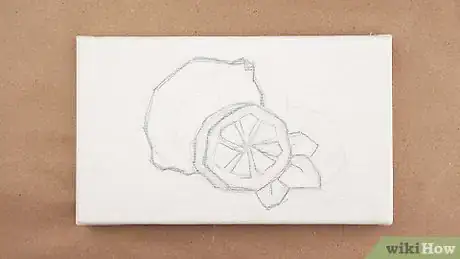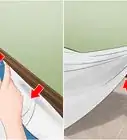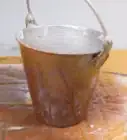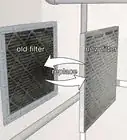This article was co-authored by Renée Plevy. Renée Plevy is an Internationally Acclaimed Portrait Artist from New York/Palm Beach who has painted The Grand Dames of Palm Beach and various celebrities and community leaders. With over 50 years of experience, Renée specializes in painting realistically in oil and capturing the soul of the person. She has studied under internationally renowned portrait artists John Howard Sanden, David Leffel, Robert Beverly Hale, Clyde Smith, and Leonid Gervits. Renée is featured in over 68 shows and galleries including a one-woman museum show at the Paterson Museum. She has garnered numerous awards including “Artist of the Year” from The Bloomfield Art League and First Prize from the Boca Raton Museum Artist’s Guild. Renée has even painted a portrait of celebrity, Vanilla Ice. She also teaches at the Boca Raton Museum Art School - formerly at SVA in Manhattan.
There are 7 references cited in this article, which can be found at the bottom of the page.
This article has been viewed 147,891 times.
Painting a picture is a great way to get creative. If you want to channel your inner Rembrandt or Pollock, you can learn to start developing the skills and acquiring all the materials that'll let you paint the kinds of pictures you want. Learn how to choose paints and brushes, select an appropriate subject, and who to get it on the canvas. See Step 1 for more information.
Steps
Choosing Paints and Brushes
-
1Try painting a picture with watercolors. The most widely-available, cheap, and easiest to use variety of paint is watercolor, which is available either in tubes or small plastic cases with multiple color palettes. Depending on the quality of the paint, watercolors can be light and pastoral, or quite vibrant and vivid. It's a beautiful and effective way to start, especially for landscapes and whimsical still-life paintings.[1]
- In it's basic state, watercolor paint is thick and heavy, and is made workable by wetting the brush and thinning out the paint with water, or by otherwise mixing the paint with water on a palette. It's a thin and light paint, easy to work with for beginners, though somewhat difficult to control.
- Having a good-quality paint to start with will help to avoid frustration when you get started.[2] Sennelier paints are watercolors available in both pan and tube form, of a much higher quality than your garden-variety school-supply watercolors. Try the pan to avoid having to buy lots of paints separately, and having the convenience of all the paint in one place. Schmincke and Windsor & Newton are also quality brands that are widely available at craft stores.
-
2Use acrylic paint for versatility. Quick-drying but just as versatile as oil paint, acrylics are the most common paint for amateurs and professional painters alike. Water-based, acrylic paints are easy to use and widely available at craft stores and specialty art shops, perfect for use with intricate details and abstract masterpieces. They're much less expensive than oil paints, but no less professional.[3]
- Acrylic paints most regularly are sold in tubes, like oil paint, and can be mixed on a palette with simple water to thin out and mix to create new colors. Because it dries very quickly, it's the perfect paint to layer, creating base tones to create depth and detail in landscapes, portraits, or other pictures.
Advertisement -
3Use oil paint like the masters. The most versatile, professional, and vibrant paints available are oil paints. They're also the most expensive and take the longest time to dry, but offer all kinds of advanced mixing techniques and layering options for professional painters. It might not be the best place to start, but it's something to consider for the future, or to experiment with if you're looking for a challenge.
- Oil paint is also frequently sold in water-soluble bricks, which can be worked similarly to watercolor, and can be somewhat quicker-drying than traditional tube oil paints. Get a variety of primary colors and learn to mix your own shades to cut down on the cost.
- Unless you want to glob the oil paint right from the tube onto the canvas in thick, visceral blobs like the impasto paintings of de Kooning (awesome looking, yes, but super-expensive), in addition to the paint itself, you'll also need to get some solvent to use as a paint thinner.
- If you paint with oil paints, you need to prime the surface first with basic acrylic primer, otherwise the paint will eventually destroy the canvas or paper. Any surface the paint touches, the palette or the mixing board, likewise should be primed to extend its life.
-
4Paint with natural ingredients you've got access to. Who ever said you needed to buy paint? Using berries, tea-emulsions, or even ashes on your canvas are all perfectly appropriate methods, depending on the picture you want to create.
- Food-based paints can change over time (or rot, depending on how you want to look at it). This can give your picture a time-based element, changing over the days and weeks after you finish it. Document your egg-paint before it starts to stink and throw it out in time, or acrylic-paint over it to keep it finished.
-
5Choose the right brushes for the job. Depending on the kind of paint you end up choosing for painting your picture, you'll need to get brushes appropriate to work with it.
- Use rounded-tip brushes for water-color painting. Flat-tip synthetic brushes are best for acrylic paints, while filbert-tip brushes are best for oil paints. You can experiment with different brush fibers, picking something that's appropriate for your price range.
-
6Get other necessary materials to start painting. To keep your clothes clean and your paints organized, you'll need a few more things other than paints and brushes to get started on your picture.
- Choose a canvas appropriate for the type of paint you've chosen. Use stretched canvas for heavy acrylic or oil paints, and watercolor paper for painting with watercolors. Watercolor paper will hold up to the dampness of the paints without curling or weakening.
- Keep a variety of cups set aside for the purpose of wetting your brushes, cleaning them, and keeping water close at hand if you're using watercolors. So you won't have to clean them quite as thoroughly as your drinking glasses, set aside some old glasses for the purpose.
- Get a palette or paint tray. The best surfaces on which to mix your paints, thin them out, and check their consistency is either a white plastic or enamel paint tray. This allows you to have a nice white background to check the accuracy of the color against, and you can get one with user-friendly paint wells around the edge for a few dollars. Glass plates are a common alternative.[4]
Getting Started
-
1Prepare your painting space. Dress in old clothes and get out all your supplies to get started. Any painting project will likely result in a bit of mess, so it's important to prepare for it to avoid impossible-to-remove paint stains on your carpet or other surfaces. To get started painting, find an open area with plenty of light to set yourself up.
- It's common to use an easel to paint, but not necessary. Find a hard surface, like an old clipboard to clamp your watercolor paper to, or prop a canvas up on a desk, covered with an old sheet or newspaper.
- Lay down an old sheet or newspaper on the floor, and any surface that'll be in contact with the paint. You won't have to worry about spilling if you've got a paint trap already set up, letting you concentrate on making.
-
2Sketch out your painting with pencil. While it's not a required step--you could always just start painting--it's helpful to sketch out the basic shape of the subject to use as a guide. If you want to paint a pot of flowers, you don't have to get into the tiny details of the pollen in the center, but it's a good idea to have the basic outline of the petals on the paper before you start adding color.
- Use contour lines to sketch the basic shape, and gestural lines to start getting a sense of the spatial relationship between the objects in the subject. The object will be made up of many little shapes, like many little paintings. Try to focus on the relationship between things.
- Locate the source of the line illuminating your subject and start looking at how the shade is cast upon the subject, and how you'll need to capture it with color and line.
-
3Mix a variety of colors as you need them. On your palette, spend some time mixing your paints and trying to get the kind of colors you want to use to capture your subject. Some painters will be really concerned with getting the value as accurate as possible, so it looks like "real life," while other painters might want to change things up a bit. There's no right way to do it.
- Blend a small amount of color and paint a few test strips to see how it looks on a white background, rather than mixing up a whole tube of white and blue together to make light blue. Only make as much as you'll need.
- Tint your bright colors with a small amount of white to soften them, or add black to create different shades of the color. Adding the opposite color from the color wheel to one paint will create a different "tone," giving you an endless range of possibilities.
- Using a variety of contrasting value in your painting will help to create a more dynamic sense of color in your painting. Use many tones, shades, and tints, thinking seriously about color.
-
4Practice using the brush. Learn to use, clean, and care for your brushes before you start painting. Before you're knee-deep in your masterpiece, get some experience getting the brush to hold an appropriate amount of paint and practice painting smooth, even lines with it. Don't worry about what you're painting, just paint some scratch while you're mixing up colors or thinning the paint out.
- Use short little brush strokes and long even ones. Use as little paint as possible on your brush to get the value you're looking for. Don't saturate the page with paint. Use different brushes for their different effects, blotting, drawing, and stippling with them.
-
5Paint the background first. Usually, you'll want to get the background in first, working from the back to the front of the painting. This lets you move from the general to the specific details, adding layers to create little details, rather than the other way around. If you start on the petals, the painting can end up looking out of balance. Experiment some to see what works best for you.
- Bob Ross, everyone's favorite television painter, was excellent at starting his paintings with backgrounds on the fly and using the imagination to get started. He usually found complementary colors and dry-brushed the background in nice sunset colors, then started filling in trees and other natural scenes without planning much of anything. It's an excellent way to get started on a canvas.
Painting Your Painting
-
1Start painting your subject and let accidents happen. Just start painting gently, using tiny amounts of paint on your brush to start forming shapes. If you're just painting from your imagination, let the paint create the shapes and follow the shapes. If you've already started with a sketch, once you've got a good background of colors on your page or canvas, you can start overlapping colors and shapes to create a sense of space.
- As you start in on painting your subject, you need to work hard to make the flat surface look more dynamic and three-dimensional.
- Create perspective by spacing the objects appropriately. If everything is equidistant and the same shape, it'll look flat on your paper, rather than dynamic. Things farther back in the subject should be proportionately smaller, while things closer up should be larger.[5]
- Some painters find it effective to put their painting upside down to examine it. The mind supplies a symbolic version of what you're painting--in your mind, you know what an apple is, so you'll tend to paint that version of the apple, rather than what you're seeing in front of you. Looking from another perspective sometimes can help you see the shapes for what they are, rather than the symbols.
-
2Add color from light to dark. Identify the light source and the shadow to start adding value to the painting. Start adding the lightest colors and gradually create the darker tones. It's much easier to layer darker colors over lighter colors, rather than the other way around. Don't paint yourself into a corner. Mix small amounts of paint as you go, adding color judiciously and slowly.
-
3Use your brush to create texture. Vary the amount of paint on your brush and the kinds of strokes you use with the brush to make different textures. Short little strokes can look like fur, while longer smoother strokes will flatten out the paint. Using less paint can help "age" the subject, while using more can thicken it and create density.
- If you screw up a part by adding too much paint, don't panic. Embrace happy accidents and integrate them into the painting. Don't spend too much extra time layering over it, just let it be and look back over it at the end to see how it effects the composition. Keep moving forward.
-
4Work on one thing at a time. It's a good idea to focus on one part of the painting, working it through, before moving around. But figure out what works best for you. Some painters jump around the page, painting in different regions, depending on the shapes and the subject being painted. It'll depend on you. But in general, keep working on one part of the painting before moving elsewhere.
- It's also important to stand back and appreciate the "big picture." Pay attention to how your little moments affect the overall composition and the painting itself.
-
5Make the painting move. Even if you're just painting a stack of books or a bowl of oranges, it needs to force the eye to move around it. Everything from the composition, to the use of color should be varied and textured, something that takes time and practice.
- Try studying color theory a bit to get more of a sense of how to use color, if you feel like your picture is looking flat.
-
6Keep at it. Painting is hard work! Don't get frustrated when you're first getting started. Now that you've got all the materials and the space set up, experiment with painting different subjects and keep developing your craft. If you tend more toward one type of painting, switch it up every now and then and paint different types of pictures. Keep making things.
Choosing Subjects
-
1Paint a landscape. Landscapes are one of the most universally-beloved and classical subjects for displaying your skills and appreciating the natural world. Landscape values perspective and depth, finding an angle into the natural world and capturing it in paints. It's a task to which some artists devote a lifetime.
- You don't have to live at the foot of a mountain or in the middle of the desert to paint beautiful landscapes. Head to the backyard and find a good angle on the shed, or an adjacent field with an interesting perspective to start your landscape.
- With the rise of Transcendentalism and Naturalism in the 1800s, landscape painting became elevated to a high level of appreciation and status, though painting the outdoors has been common since the Minoan period of art history. Nowadays, it's common for landscapes to portray human influence--roads, billboards, even cars.
-
2Paint a portrait. Find a human or animal subject, light them well, and place them against a blank backdrop to study the form of life. This will take a steady pencil to get the details right, or you can take a more impressionistic approach to the subject and try to get at their essence, if not a picture-perfect representation.
- In general, the portrait is all about detail: some of the most successful Renaissance portrait artists were even originally trained in etching and gold-work to become accustomed to working small.[6] There's no wrong way to paint a portrait.
- Study life drawing to learn about capturing the human form in the proper proportions and movement. Consider working from a photograph to avoid making your subject stay still for hours at a time. Or, go the old-fashioned route and sit them down with a glass of wine and some classical music to keep them relaxed.
- Self-portraits are also a common and vibrant form to explore. Set up a mirror and paint what you see in it. Find your inner Rembrandt.
-
3Paint a still life. Assemble a directly-lit group of objects on a table to study and paint. Flowers, fruits and vegetables, toys, and other various and sundry items are all perfect for a modern still life. Assemble them in an aesthetically-pleasing way on a table, with enough lighting to cast shadow and create depth, then get to work.
- Classical still-life painting involves its own particular symbolic tradition and themes, with simple-looking table scapes representing complex metaphorical tableaux, called vanitas--Latin for vanity.[7] The collection of flowers and foods, ephemeral and natural things, are sometimes meant to signify mortality, while the classical Golden age of still life painting use opulent displays to celebrate wealth. In some regions, harvest collections would be assembled to celebrate the completion of labor and agriculture.
-
4Paint musically. Break the rules. Paint abstract-expressionist experiments. Put some hard bop jazz on the record player and paint what you hear, mixing your colors on the fly and providing visuals for sounds, or capture other abstractions in color.
- Whatever your materials or your subject, feel no pressure to paint representatively, or "accurately." Want to paint caricature or exaggerated cartoonish versions of your subjects? Go for it.
Community Q&A
-
QuestionHow do I start a picture?
 Community AnswerAny way you want! Some people prefer to carefully plan their picture before they get started, for example by sketching it up very loosely in pencil before starting to apply color. Others like to just go for it without knowing how the picture will turn out, to just create intuitively. If you have little experience with painting, don't worry about it! It takes some time to figure out your own creative process. Just experiment. Most importantly, don't take it too seriously. It's okay to make mistakes and painting should be fun.
Community AnswerAny way you want! Some people prefer to carefully plan their picture before they get started, for example by sketching it up very loosely in pencil before starting to apply color. Others like to just go for it without knowing how the picture will turn out, to just create intuitively. If you have little experience with painting, don't worry about it! It takes some time to figure out your own creative process. Just experiment. Most importantly, don't take it too seriously. It's okay to make mistakes and painting should be fun. -
QuestionHow do I get a transparent look, like for clear glass?
 Community AnswerUse a lot of water in the paint to dilute it. This should help with the transparent look. Also, you can use water colors.
Community AnswerUse a lot of water in the paint to dilute it. This should help with the transparent look. Also, you can use water colors. -
QuestionWhat animals are good to paint?
 PhishtacheoCommunity AnswerHonestly, any. But I find birds are pretty fun for me personally. It's all a matter of opinion and choice.
PhishtacheoCommunity AnswerHonestly, any. But I find birds are pretty fun for me personally. It's all a matter of opinion and choice.
Things You'll Need
- Palette
- Water
- Paint
- Surface to paint on
- Brushes
- Paper towels
References
- ↑ http://www.handprint.com/HP/WCL/tech14.html
- ↑ Renée Plevy. Portrait Artist & Educator. Expert Interview. 7 May 2021.
- ↑ http://emptyeasel.com/2007/01/16/how-to-choose-between-using-oil-paints-or-acrylics/
- ↑ http://www.artistsnetwork.com/medium/acrylic/what-to-know-when-learning-how-to-paint-with-acrylics
- ↑ http://www.studentartguide.com/articles/how-to-draw-and-paint-faster
- ↑ http://www.metmuseum.org/toah/hd/bpor/hd_bpor.htm
- ↑ http://www.easy-oil-painting-techniques.org/still-life-symbolism.html
About This Article
To paint a picture, choose the type of paint you want to use, then sketch out the basic design or composition on your paper or canvas surface. Fill in the background first and let the paint dry. Then, paint in the objects, focusing on one area at a time. Be sure to paint the basic shapes first and leave the details for last. It can help to take a step back occasionally to check your progress! For tips on choosing subjects for your compositions, read on!






































































